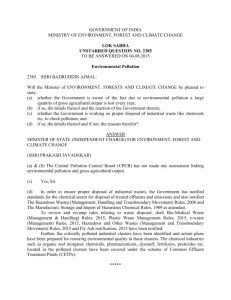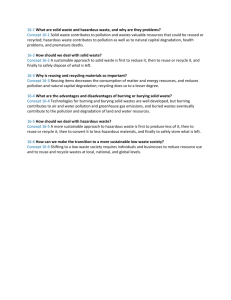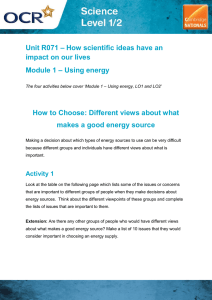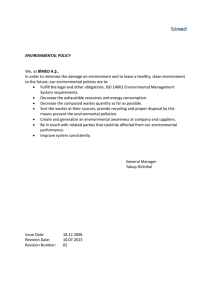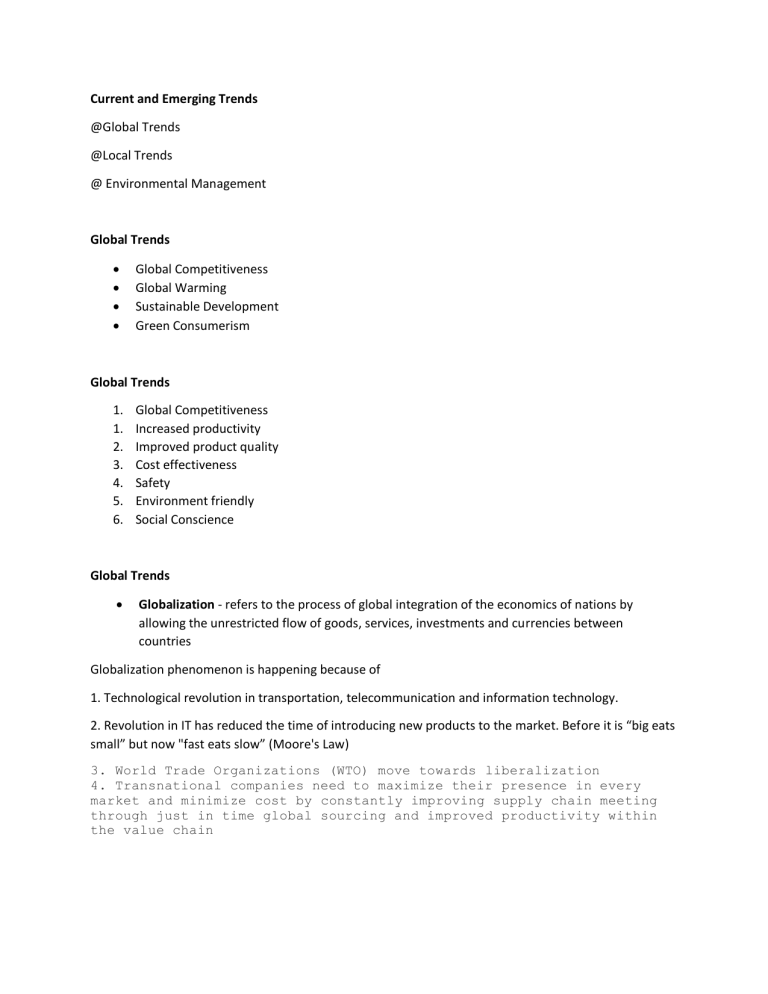
Current and Emerging Trends @Global Trends @Local Trends @ Environmental Management Global Trends Global Competitiveness Global Warming Sustainable Development Green Consumerism Global Trends 1. 1. 2. 3. 4. 5. 6. Global Competitiveness Increased productivity Improved product quality Cost effectiveness Safety Environment friendly Social Conscience Global Trends Globalization - refers to the process of global integration of the economics of nations by allowing the unrestricted flow of goods, services, investments and currencies between countries Globalization phenomenon is happening because of 1. Technological revolution in transportation, telecommunication and information technology. 2. Revolution in IT has reduced the time of introducing new products to the market. Before it is “big eats small” but now "fast eats slow” (Moore's Law) 3. World Trade Organizations (WTO) move towards liberalization 4. Transnational companies need to maximize their presence in every market and minimize cost by constantly improving supply chain meeting through just in time global sourcing and improved productivity within the value chain Global Competitiveness The global economy is facing rising food and energy prices, a major international financial crisis and the slowdown in the world's leading economies. These challenges require each economy to increase its global competitiveness to ensure solid economic performance today and in the future. Global Competitiveness The World Economic Forum's annual Global Competitiveness Report 20082009 ranked the Philippines at 71 out of 134 countries. Competitiveness is defined as the set of institutions, policies and factors that determine the level of productivity of a country. The level of productivity sets the natural level of productivity of a country. The level of productivity sets the sustainable level of prosperity that can be earned by an economy. More competitive economies tend to be able to produce higher levels of income for their citizens. The productivity level also determines the rate of return obtained by investments in an economy. In a smaller scale, a company must be able to increase productivity, lower cost and ensure high quality and safety products to be able to compete in the market. Certifications such as ISO (e.g. ISO 9000, 14000, 22000), HACCP, HALAL and Social Accountability 8000 can add to the competitiveness of a company especially if their clients/ market requires them to have certifications Global Warming Global Warming is a concern of everyone. For over the past 200 years, the burning of fossil fuels, such as coal and oil, and deforestation have caused the concentrations of heat trapping "greenhouse gases" to increase significantly in our atmosphere. These gases prevent heat from escaping to space. As the concentration of these gases continue to increase in the atmosphere, the earth's temperature is climbing above past levels causing climate change and rising sea level The Intergovernmental Panel on Climate Change (IPCC, 2007) concluded that: Human beings are exposed to climate change through changing weather patterns. One major move to address global warming/ climate change is Kyoto Protocol, which contains legally binding emission targets for developed countries for the post 2000 period. They have committed to reduce their collective emissions of six key greenhouse gases by at least 5%. The Clean Development Mechanism under this protocol enables the industrialized countries to finance emission reduction projects in developing countries and receive credit for doing so. Global Warming Fingerprints: Heat waves and periods of unusually warm weather Ocean warming, sea level rise, coastal flooding Glacier's melting Arctic and Antarctic warming Spreading Disease Earlier spring arrival Plant and animal range shifts and population change Coral reef bleaching Downpours, heavy snowfalls and flooding Droughts and fires Local Scenarios due to Global Warming Increasing cases of dengue fever, typhoid fever and cholera Stronger Typhoons (e.g. Milenyo, Frank) Coral bleaching Hotter summer days Rising sea level Earth Hour — an international event created by the WVVF, held on the last Sunday of March that asks households and businesses to turn off their essential lights and electrical appliances for one hour to raise awareness towards the need to take action on global warming Local Trends Food Safety Energy Conservation Environmental Issues Health and Safety Community Issues Food safety Current Good Manufacturing Practices (cGMP) -sets of sanitation guidelines for the food handlers in a food processing plant or establishment to ensure safe wholesome and quality products Hazard Analysis and Critical Control Points (HACCP) -a scientific, rational and systematic approach to identification, assessment and control of hazards during production, processing, manufacturing, preparation and use of food to ensure that food is safe when consumed. 7 Principles of HACCP 1. Conduct a hazard analysis 2. Identify critical control points 3. Establish critical limits for each critical control point. 4. Establish critical control point monitoring requirements. 5. Establish corrective actions. 6. Establish procedures for ensuring the HACCP system working as intended. 7. Establish record keeping procedures. ISO 22000 -specifies the requirements for a food safety management system that involves the following elements: interactive communication system management prerequisite programs HACCP principles Energy Conservation Why do we need to conserve energy? High Cost of Electricity Low/ diminishing supply of fossil fuel Environmental Impacts (eg. Air Pollution, Global Warming) 1. Energy Management -steps taken to minimize energy that is used and wasted 2. Energy Efficiency -conservation and use of energy; a measure of the productivity per unit of energy consumed; employs devices which results in less energy being used for the same task and function 3. Energy Conservation -saving energy by any means including energy efficiency and adopting practices to reduce energy consumption 4. Improved energy efficiency and conservation -provide the greatest scope for reducing energy requirements and its negative impact to the environment 5. CR Energy Audit -critical assessment of an energy consuming facility; an effective energy management tool 6. National Energy Efficiency and Conservation Program (NEECP) -declared policy of the government to promote the judicious conservation and efficient utilization of energy resources through adoption of the cost-effective options- toward the efficient use of energy to minimize environmental impact. Environmental Issues Environmental Laws and Regulations RA 6969 (Toxic Substance and Hazardous and Nuclear Wastes Act) -AN ACT TO CONTROL TOXIC SUBSTANCES AND HAZARDOUS AND NUCLEAR WASTES, PROVIDING PENALTIES FOR VIOLATIONS THEREOF, AND FOR OTHER PURPOSES. DAO 92-29 -IMPLEMENTING RULES AND REGULATIONS OF REPUBLIC ACT 6969 RA 9003 (Ecological Solid Waste Management Act) -AN ACT PROVIDING FOR AN ECOLOGICAL SOLID WASTE MANAGEMENT PROGRAM, CREATING THE NECESSARY INSTITUTIONAL MECHANISMS AND INCENTIVES, DECLARING CERTAIN ACTS PROHIBITED AND PROVIDING PENALTIES, APPROPRIATING FUNDS THEREFOR, AND FOR OTHER PURPOSES RA 8749 (Clean Air Act) -AN ACT PROVIDING FOR A COMPREHENSIVE AIR POLLUTION CONTROL POLICY AND FOR OTHER PURPOSES. DAO 2000-81 -IRR for RA 8749 RA 9275 (Clean Water Act) -AN ACT PROVIDING FOR A COMPREHENSIVE WATER QUALITY MANAGEMENT AND FOR OTHER PURPOSES DAO 05-10 -IRR for RA9275 PD 586 (Environmental Impact Assessment System) -AMENDING REPUBLIC ACT NO. 6372 ENTITLED: "AN ACT CREATING THE MUNICIPALITY OF DUPAX DEL SUR FROM THE MUNICIPALITY OF DUPAX IN THE PROVINCE OF NUEVA VIZCAYA," INSERTING NEW SECTIONS THEREIN, PROVIDING FOR IMPLEMENT A TION THEREOF. DAO 96-37 -IRR for EIS RA 9367 (Biofuels Act) -AN ACT TO DIRECT THE USE OF BIOFUELS, ESTABLISHING FOR THIS PURPOSE THE BIOFUEL PROGRAM, APPROPRIATING FUNDS THEREFOR, AND FOR OTHER PURPOSES Health and Safety 1. Work Force Issues -Healthy and safe work environment -Health insurance premiums 2. Occupational Injury -any injury which results from a work accident or from exposure in the work environment Typical Occupational Injuries Cuts, Lacerations, Punctures, Avulsions Contusions, Bruises, Hematoma, Abrasions Strains, Sprains, Dislocations, Fractures Burns & Scalds (Thermal, Chemical) Crushing, Spinal, Cranial Injuries Amputations, Loss of Body Parts Foreign Body in the Eye Electrocution, Electric Shock Asphyxiation, Poisoning 3. Occupational Illness -any abnormal condition or disorder other than resulting from an occupational injury, caused by exposure to environmental factors associated with employment 4. PD 442 (Labor Code of the Philippines Article 162) -A DECREE INSTITUTING A LABOR CODE THEREBY REVISING AND CONSOLIDATING LABOR AND SOCIAL LAWS TO AFFORD PROTECTION TO LABOR, PROMOTE EMPLOYMENT AND HUMAN RESOURCES DEVELOPMENT AND INSURE INDUSTRIAL PEACE BASED ON SOCIAL JUSTICE -provides the establishment of OSH Standards (Occupational Safety and Health Standards) Community Issues Right-to-know NIMBY syndrome NIMTO Waste Segregation Participatory 5. NIMBY (Not - In - My - Back - Yard) -reflects the propensity of local citizens and officials to insist on siting unwanted but necessary facilities anywhere but in their own community. 6. NIMTO (Not - - My - Term in - Office) -no politicians will risk any challenging decisions if his/her community does not want any facilities to be built in their area 7. Minamata Disease -neurological svndrome caused by severe mercury poisoning. Symptoms include ataxia, numbness in the hands and feet, general muscle weakness, narrowing of the field of vision and damage to hearing and speech. In extreme cases, insanity, paralysis, coma, and death follow within weeks of the onset of symptoms. A congenital form of the disease can also affect fetuses in the womb. 8. Minamata Bay Tragedy -From 1932 to 1968, Chisso Corporation, a company located in Kumamoto Japan, dumped an estimated 27 tons of mercury compounds into Minamata Bay 9. Bhopal Disaster A gas leak incident in India, considered one of the world's worst industrial catastrophes. It occurred on the night of December 2—3, 1984 at the Union Carbide India Limited (UCIL) pesticide plant in Bhopal, Madhya Pradesh, India. A leak of methyl isocyanate (42 tons) gas and other chemicals from the plant resulted in the exposure of hundreds of thousands of people. 10. Marcopper Tragedy Philippines' biggest industrial accident. March 24, 1996, a tunnel in Marcopper Mining Corporation's Tapian Pit collapse and spilled 1.6 million cubic meters of mine sludge and causing biologic death of the Boac River, the biggest and longest waterway on Malinduque island. The toxic spills immediately caused flash floods which isolated five villages. Their sources of drinking water were contaminated while fish, freshwater shrimp and pigs were killed. MULTIMEDIA TRASFER OF POLLUTION Cleaner Production Pollution US EPA - Pollution is defined as any undesirable change in the chemical or biological characteristics of air, water or land that may or will harmfully affect human life or that of other undesirable species, our processes, living conditions or cultural assets or that may or will waste or deteriorate material resources. PD 984- Pollution is any alteration of the physical, chemical and biological properties of any water, air and or land resources of the Philippines or any discharge thereto of any liquid, gaseous or solid wastes will or is likely to create or to render such water, air and land resources harmful, detrimental or injurious to public health, safety or welfare or which will adversely affect their utilization for domestic, commercial, industrial, agricultural creational or other legitimate purposes. APPLICATION OF POLLUTION CONTROL TECHNIQUES (END-PF-PIPE TREATMENT) After employing end-o Pipe treatment technologies, the pollutant may still contaminate environment and pose health hazards since technologies like air pollution control devices (APCD) and wastewater treatment plants (WWTP or WTP) often times have high capital investments and are expensive to operate. Increase of wastes is associated with the depletion of most of the nonrenewable resources. The energy required to transform and upgrade these wastes is proportional to the quantities being treated and rises exponentially with increasing dilution of the waste. Total cost of collections for collection, segregation, intermediate storage, transport, treatment and final storage make pollution prevention economically attractive. Pollution prevention is the use of materials, processes, or processes that reduce or eliminate the creation of pollutants or wastes as the sources- includes practices that reduce the use of hazardous and nonhazardous material, energy, water or other resources as well as those that protect natural resources through conservation or more LCA studies are conducted for the purpose of answering certain questions, and those questions drive the design of the LCA study. Ex: How does the potential environmental impact of a new product compare to that of products that are already on the market? Life Cycle Analysis (LCA) is also known as eco-balance, cradle to grave analysis, resource analysis, environmental impact analysis. LCA is an analysis of a product or service system throughout all stages of the life cycle raw materials acquisition, manufacturing, transportation, use/reuse/maintenance recycling waste management, and the relevant energy supply systems TREND: 1. COMPLY WITH REGULATIONS THROUGH THE CONSTRUCTION OR INSTALLATION OF WASTEWATER TREATMENT PLANTS POLLUTION CONTROL DEVICES, 2. ENVIRONMENT, HEALTH AND SAFETY (EHS) WERE PERFORMED by STAFF DESIGNATED FOR THESE RESPONSIBILITIES. COMPANY PERSONNEL ACT AS EHS OFFICER OR COORDINATORS BECAUSE THE LAW SIMPLY REQUIRES THEN TO, TODAY, MORE AND MORE COMPANIES HAVE REALIZED THE ADVANTAGES OF PREVENTING POLLUTION BEFORE THEY OCCUR, PRODUCTS ARE BEING VIEWEP FROM THE CUSTOMER SIDE, DESIGN, MANUFACTURE, TRANSPORT, USE FINAL DISPOSAL, EHS ARE NOW FACETS COMPANY'S OPERATION, Cleaner Production - refers to a mentality of how goods and services are produces with the minimum environmental impact under present technological and economic limits. CP is a "win-win" strategy. It protects the environment, the consumer and the worker while improving industrial efficiency, profitability and competitiveness. Other related terms to CP are: Pollution prevention Waste minimization Eco-profitability Green productivity Low and non-waste technologies. Zero waste emission The key difference between pollution control (PC) and CP is one of timing. PC is an after-the-event, 'react and treat' approach. CP is a forward-looking, anticipate and prevent philosophy. CP can be applied to processes used in any industry, to products themselves and to various services provided in society. For production processes - combination of conserving raw materials, water, energy; eliminating toxic raw materials; and reducing the quantity and toxicity of all emissions and wastes at source during the production process. For products - CP aims to reduce the environmental health and safety impacts of products over their life cycles, from raw material extraction, through manufacturing and use, to its "ultimate disposal of productsFor services - CP implies incorporating environmental concerns into design. Benefits of CP 1. Increased plant productivity thru more efficient use of raw materials due to improve processes and operations. 2. Reduced operating costs - by adapting production and packaging procedures that consume fewer resources, thereby creating less wastes- As wastes are reduced, the percentage of raw materials converted to finished products increases, with a proportional decrease in material costs- Other operating costs involved like waste management may also be reduced. 3. Public health and Environmental benefits — CP reduces the generation of wastes at the source, or results in less hazardous waste, and thus assures improved public health and environmental protection- Likewise the consumption of less raw materials rebounds to the conservation of natural mineral resources. 4. Work Health and Safety - By reducing or eliminating toxic substance use, the safety of the work environment can be improved and personal protective equipment requirement decreased. Also, reducing the likelihood of leaks, spills and releases can decrease worker, visitor, and contractor exposure. 5. Reduced Risk of Liability - CP can reduce regulatory exposure, and in some cases, may eliminate the need for permits, manifesting, monitoring and reporting. CP can help reduce longterm liability by reducing the amount and the hazard of waste generated. 6. Improve Corporate Image and Improved Global Competitiveness. Practicing CP can enhance the company's public image and may also increase the acceptance of its product globally. Business definition of waste - anything other than the minimum amount of equipment, materials, parts and worker's time which is absolutely essential to add value to product. - 3M Waste 1. 2. 3. 4. Management Hierarchy Source reduction Recycling Treatment Disposal Source reduction involves product or process changes that reduce pollution at source Product changes in the composition or use of the intermediate or end products are performed by the manufacturer with the purpose of reducing waste from the manufacture, use or ultimate disposal of the products. Product changes include: Changes in quality standards Changes in product composition Increase in product durability Product substitution Product changes can lead to changes in design and composition. The new product can thus have less environmental impacts throughout its life cycle; from raw material extraction to final disposal. Input material changes in raw materials accomplish CP by reducing or eliminating the hazardous materials that enter the production process. Also, changes in input materials can be made to avoid the generation of hazardous wastes within the production process. Input material changes include material substitution. Technology changes are oriented towards process and equipment modifications to reduce waste and emissions, preliminary in a production setting. Technology changes can range from minor changes that can be implemented in a matter of days at low cost to the replacement of processes involving large capital cost. Technology changes include the ff: 1. Changes in the production process 2. Modification of equipment, layout or piping 3. Use of automation 4. Changes in process conditions, such as flow rates, temperatures, pressures and residence times. IMPROVED OPERATING PRACTICE> * OPERATING/MAINTENANCE PROCEDURES * MANAGEMENT PRACTICES * MATERIALS HANDLING IMPROVEMENTS * INVENTORY CONTROL * PRODUCTION SCHEDULING * STREAM SEGREGATION * WASTE SEGREGATION * TRAINING Many of these measures are used in industry largely as efficiency improvements and good management practices. Good operating practices can often be implemented with little cost. These practices can be implemented in all areas of the plant, including production, maintenance operations and in raw material and product storage. Management and personnel practices: Includes employee training, incentives and bonuses, and other programs that encourage employees to conscientiously strive to reduce waste and emission. Materials handling and inventory practices: Includes programs to reduce loss of input materials due to mishandling, expired shelf life of timesensitive materials and proper storage conditions. Production scheduling: By analyzing these factors, the departments or groups that generate wastes and emissions become more aware of the effects of their treatment and disposal practices, and have a financial incentive to minimize their wastes and emissions. By judicious scheduling of batch production runs, the frequency of equipment cleaning and the resulting wastes and emissions can be reduced. Waste segregation and stream segregation: these practices reduce the volume of hazardous materials/wastes by hazardous materials/wastes. Reuse - A material is being reuse if it serves the same purpose and objective as its previous usage. Reuse means reutilization of a material in an environmentally sound manner that will not result in a hazard to human health or the environment. A material is reuse if it is either: Employed as an ingredient, including use as an intermediate industrial process to make a product Used in particular function or application as an effective substitute for a commercial product. Reclaim: A material is reclaimed if it is processes to recover a usable product or if it is regenerated. Recycling can either be accomplished within the same manufacturing process by methods such as distilling a spent solvent for reuse. Or it may involve sending waste materials off-site for recycling if the company is unable to reuse the material on-site, as in the case of spent lead-acid batteries. Part of recycling is the need to close the recycling loop by emphasizing the use of recycled material wherever feasible. TREATMENT AND DISPOSAL Treatment of waste can include incineration, neutralization, precipitation, or other chemical or physical methods to prepare a waste for release to the environment by making it less hazardous. Most common treatment technology present in almost all industry is the wastewater treatment, plant/facility (WWTP) where wastewater with high biological oxygen demand (BOD) and chemical oxygen demand (COD) are treated prior t discharge in bodies of water; Treated, semi-treated or untreated wastes go to the sanitary landfills or hazardous landfills. A secure landfill is a carefully engineered depression in the ground into which wastes are put. The aim is to avoid any hydraulic (water related) connection between the wastes and the surrounding environment particularly groundwater. 4 Critical elements in a secure landfill: 1. 2. 3. 4. Bottom Liner Leachate collection Cover Natural hydrogeologic setting The natural setting can be selected to minimize the possibility of wastes escaping to ground water beneath a landfill. CP PROGRAM OVERVIEW General steps in establishing the CP Program 1. Top management commitment- Getting top management support is necessary to have an effective CP program. 2. Planning and Organizing - Organizing a CP begins by naming the CP task force, formulating the CP goals and identifying driving and restraining forces in implementing CP. 3. Assessment- Conducting a detailed CP assessment on the facility and generating options. 4. Feasibility analysis - Evaluating CP options to determine which are technically, economically and environmentally feasible. 5. Implementation - Selecting projects. Obtaining funds and installing of the selected projects for implementation 6. Monitoring and evaluation- Monitoring of the implemented projects and evaluating economic and environmental performance. 7. Maintaining and sustaining CP program for continued growth and continued benefits to the company.

